For those searching for a single-entry workflow that spans prompt-driven image creation, targeted image editing, image-to-video conversion and on-demand article generation, coopeai.com presents a compelling value proposition. This article examines where that promise fits into the broader AI-visual ecosystem, how creative teams can operationalize it, and what opportunities and risks to expect moving forward.
Why an all-in-one visual AI tool changes creative workflows
Think of a creative pipeline as a railway yard: raw ideas are freight cars that need sorting, combining and routing. Historically designers used separate yards—one for concept art, another for photo retouch, another for motion. An integrated platform like coopeai collapses those yards into a single terminal, reducing handoffs and enabling rapid iteration. For agencies and solo creators this lowers friction: a text prompt becomes a concept image, which can be refined and then converted into a short animated clip without exporting between multiple tools.
This matters because speed and coherence are now competitive advantages. Brands that can spin up visual concepts, test them in ads or short video formats, and iterate in hours (instead of days) will outpace rivals in attention-driven channels.
Core capabilities and what they enable in practice
- Text-to-image: Rapid prototyping of visual concepts—moodboards, product mockups, thumbnails. This accelerates ideation cycles.
- Image editing (inpainting/outpainting): Precise control for brand consistency—swap backgrounds, remove elements, or adapt an asset for multiple formats.
- Image-to-video conversion: Short-form animated assets for social feeds; turning a still into a parallax or a 3–6 second teaser multiplies the utility of a single creative.
- Article generation: Synchronous short-copy generation to pair with visuals—captions, descriptions, or A/B variations for ad copy.
These features combined let a small team produce a multi-format campaign from one session: prompt an image, refine it, export a 10–15s clip, and auto-generate three headline/caption variations for testing.

Caption: A visual workflow from prompt to still to short clip, illustrating integrated iteration.
Technical lineage and where coopeai sits among models
Most modern image-generation services combine diffusion-based backbones (such as latent diffusion) with tuned conditioning and inpainting modules. For a technical primer on the diffusion approach that underpins many systems, see the Latent Diffusion paper: Latent Diffusion Models. For industry-level image endpoints and best practices, refer to OpenAI Images Guide.
What differentiates platform offerings is not only the base model but also: prompt engineering UX, how seamlessly editing tools are exposed, video conversion fidelity, and content safety pipelines. A well-designed UI that abstracts technical complexity while preserving control will win adoption among marketers and designers.

Caption: Close-up of image editing controls enabling targeted inpainting and style matching.
Practical workflow: from brief to multi-format deliverable in one session
- Start with a concise creative brief (visual mood, color palette, target platform).
- Use coopeai’s text-to-image to generate 4–8 seeds. Iterate by selecting the best seed and applying localized edits (change background, swap objects).
- Export a refined still and invoke image-to-video to add parallax, subtle motion or camera push—produce a 6–12 second clip optimized for Reels/TikTok.
- Generate 3 headline/caption variants with the article generation module and pair them for A/B testing.
This single-session loop turns one creative spark into a small campaign while keeping brand parameters consistent.
Business and legal considerations for adopters
- Intellectual property: Understand licensing terms—who owns output, and are there dataset-attribution requirements? Many vendors offer different license models for commercial use.
- Brand safety and model hallucination: AI often invents details; for product images, avoid publishing AI-generated visuals that misrepresent real specifications. Implement human review in the loop.
- Compliance and content filters: Platforms must implement filters for disallowed content; validate that the tool meets your jurisdictional requirements.
Companies should draft clear policies: approved-use cases, mandatory review steps for product claims, and a record of prompts/outputs for auditability.
Where the market is going and how to position your team
Short-term (12–24 months): Integrated stacks that combine text-image-video workflows will become table stakes for content ops. Expect improved temporal coherence in image-to-video conversions and faster fine-tuning for brand styles.
Mid-term (2–4 years): Real-time collaborative editing (multiple users co-editing a prompt and timeline) and stronger API ecosystems for programmatic campaign generation will appear. Commercial tools that provide provenance metadata and robust licensing will displace ad-hoc solutions.
Strategic advice: invest in prompt literacy, create brand-specific style guides expressed as prompt templates, and build a lightweight review workflow that balances speed with legal safety.
Quick comparison checklist when evaluating coopeai or similar platforms
- Does the platform provide explicit commercial licensing and provenance metadata?
- How granular are editing tools (pixel-level inpainting vs. global style sliders)?
- What is the fidelity and frame-coherence of image-to-video conversions?
- Are generated articles customizable for tone and length, and do they export cleanly for CMS or ad platforms?
Answering these will determine whether a tool is suitable for enterprise use or better for rapid prototyping.

Caption: Comparison matrix concept showing feature vs. enterprise needs.
Final perspective: when to adopt and when to pilot
Adopt if your team needs fast multi-format creative output, values low-friction iteration, and can enforce a human review stage for final assets. Pilot if you require high-fidelity product visuals that must match exact specifications or if your legal team needs to vet licensing in depth.
For technical background on image generation methods and best practices, consult the Latent Diffusion paper: Latent Diffusion Models and the broader industry guidance on image endpoints: OpenAI Images Guide.